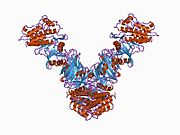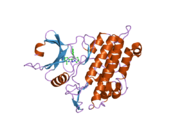TGF beta receptor 1
Ensembl | |||||||||
|---|---|---|---|---|---|---|---|---|---|
| UniProt | |||||||||
| RefSeq (mRNA) | |||||||||
| RefSeq (protein) | |||||||||
| Location (UCSC) | Chr 9: 99.1 – 99.15 Mb | Chr 4: 47.35 – 47.41 Mb | |||||||
| PubMed search | [3] | [4] | |||||||
| View/Edit Human | View/Edit Mouse |
Transforming growth factor beta receptor I (activin A receptor type II-like kinase, 53kDa) is a membrane-bound TGF beta receptor protein of the TGF-beta receptor family for the TGF beta superfamily of signaling ligands. TGFBR1 is its human gene.
Function
The protein encoded by this gene forms a heteromeric complex with
Interactions
TGF beta receptor 1 has been shown to
Inhibitors
- GW-788,388
- LY-2109761
- Galunisertib (LY-2157299)
- SB-431,542
- SB-525,334
- RepSox[24]
Animal studies
Defects are observed when the TGFBR-1 gene is either
In mouse TGFBR-1 knock-out models, the female mice were sterile. They developed oviductal diverticula and defective uterine smooth muscle, meaning that uterine smooth muscle layers were poorly formed. Oviductal diverticula are small, bulging pouches located on the oviduct, which is the tube that transports the ovum from the ovary to the uterus. This deformity of the oviduct occurred bilaterally and resulted in impaired embryo development and impaired transit of the embryos to the uterus. Ovulation and fertilization still occurred in the knock-outs, however remnants of embryos were found in these oviductal diverticula.[25]
In mouse TGFBR-1 knock-in models where a constitutively active TGFBR-1 gene is conditionally induced, the over-activation of the TGFBR-1 receptors lead to infertility, a reduction in the number of uterine glands, and hypermuscled uteri (an increased amount of smooth muscle in the uteri).[26]
Research into how turning off the TGFBR-1 gene affects spinal cord development in mice led to the discovery that, when the gene is turned off, external genitalia instead form as two hind legs.[27]
These experiments show that the TGFB-1 receptor plays a critical role in the function of the female reproductive tract. They also show that genetic mutations in the TGFBR-1 gene may lead to fertility issues in women.
References
- ^ a b c GRCh38: Ensembl release 89: ENSG00000106799 – Ensembl, May 2017
- ^ a b c GRCm38: Ensembl release 89: ENSMUSG00000007613 – Ensembl, May 2017
- ^ "Human PubMed Reference:". National Center for Biotechnology Information, U.S. National Library of Medicine.
- ^ "Mouse PubMed Reference:". National Center for Biotechnology Information, U.S. National Library of Medicine.
- ^ "Entrez Gene: TGFBR1 transforming growth factor, beta receptor I (activin A receptor type II-like kinase, 53kDa)".
- ^ PMID 11102446.
- PMID 12015308.
- PMID 9872992.
- PMID 7518616.
- PMID 7791754.
- PMID 8530343.
- PMID 18591668.
- PMID 15148321.
- PMID 14722617.
- PMID 14657019.
- PMID 11163210.
- S2CID 16552782.
- ^ PMID 10757800.
- PMID 9774674.
- PMID 9856985.
- PMID 8235612.
- PMID 10716993.
- PMID 7890683.
- S2CID 247355285.
- PMID 22028666.
- PMID 25505200.
- .
Further reading
- Massagué J (June 1992). "Receptors for the TGF-beta family". Cell. 69 (7): 1067–70. S2CID 54268875.
- Wrana JL (1998). "TGF-beta receptors and signalling mechanisms". Mineral and Electrolyte Metabolism. 24 (2–3): 120–30. S2CID 84458561.
- Josso N, di Clemente N, Gouédard L (June 2001). "Anti-Müllerian hormone and its receptors". Molecular and Cellular Endocrinology. 179 (1–2): 25–32. S2CID 27316217.





